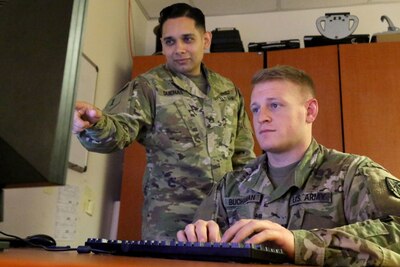By Army Staff Sgt. Monik Phan 35th Air Defense Artillery
Brigade
OSAN AIR BASE, South Korea, Sept. 14, 2017 — More than four
stories below the entrance of 35th Air Defense Artillery Brigade headquarters
here, teams of soldiers provide around-the-clock, real-time surveillance of the
tactical ballistic missile threat on the Korean Peninsula.
Despite their moniker that conjures thoughts of the fantasy
role-playing game Dungeons and Dragons, these soldiers fully understand their
real-world mission, and the vital role they play. The Dungeon Dragons of the
Dragon Brigade are essential in monitoring, receiving and disseminating
information to ensure U.S. ballistic missile defense is ready to fight tonight.
The Fire Direction Center, in concert with the soldiers that
work in the Air Defense Artillery Fire Control Officer office, are not like
other staff sections. There is a bond among the group that resembles a football
team playing deep into the playoffs -- they are a close bunch. Their closeness
is forged in long hours, lost weekends and a clear understanding of the impact
they have on the millions of people that call South Korea home.
Fight Tonight
From the most southern point in South Korea to the 38th
parallel, the 8th Army mantra of fight tonight reverberates throughout every
unit.
“The primary mission of the FDC and the ADAFCO is to provide
situational awareness to our brigade commander on the Korean Peninsula,” said
Army Staff Sgt. Raul Duenas, an air defense battle management system operator
with Headquarters and Headquarters Battery, 35th ADA Brigade.
As an air defense battle management system operator, Duenas
works in the FDC and monitors multiple systems that provide a common operating
picture of tactical ballistic missiles and air breathing threats. The images
are depicted with detailed information to enable his team to submit
time-sensitive reports situational awareness if a missile is launched.
“If something were to happen, we would be the first people
to know about it,” Duenas said. “We will be the first ones to see it. We will
have to quickly react to make the necessary phone calls and disseminate
information about the event.”
The FDC and ADAFCO personnel work around the clock to ensure
every potential threat is observed. Their systems are always collecting and
saving data so they can quickly analyze the information to prepare and
consolidate situational reports for the brigade command team.
“Our job is to monitor the [radar] screens to see the first
signs of any threat,” said Army Spc. Ryan Buchanan, an Air Defense Enhanced
Early Warning Operator from Headquarters and Headquarters Battery, 35th ADA
Brigade. Buchanan is among the soldiers who are under Duenas’ supervision.
The brigade’s monitoring systems are capable of identifying
the type of missile launched through the
use of advanced radar technology, said Army Spc. Christopher Lee, an air
defense battle management system operator from HHB, 35th ADA Brigade.
Due to the North Korean threat, the brigade is always
conducting training to keep their units prepared, said Army Pfc. Dorold Nguyen,
a Patriot Fire Control Enhanced Operator/Maintainer with HHB, 35th ADA Brigade.
The units are always training to ensure everything is fully missioned capable
and batteries are at the directed posture of readiness.
One of the most essential components within the ADA
community is the data-link architecture that allows units to communicate with
each other while they are geographically dispersed, Nguyen said. Although there
are measures in place for units to fight autonomously if needed, the brigade is
most effective when communication links are networked.
“We are always testing our communication links between
batteries and battalions to make sure they stay running,” Nguyen said. “When
everyone passes the information among each other, it helps us fight together.”
Training
The brigade recently completed an internal exercise with
their South Korean counterparts here to prepare for the annual peninsula-wide
exercise Ulchi Freedom Guardian. The purpose of the training was to ensure the
brigade’s operation centers, along with the crews that fight the air battles
during UFG, are familiar with their systems and processes.
One of the biggest benefits of the combined exercise was the
ability to conduct training and implement battle drills through digitized simulations,
said Army Staff Sgt. Jordan R. Hobbs, an air defense battle management system
operator with HHB, 35th ADA Brigade.
The brigade’s combined exercise reinforced the leadership’s
emphasis of enhancing interoperability. And, the more that units work together
in a training capacity, the better prepared they will be for real-world events.
Christopher Tarpley, event lead from Missile Defense Agency
based out of Colorado Springs, Colorado, explains the ADA exercises in South
Korea are simulated scenarios that provide a baseline of understanding of how
the South Korean military and its allied forces could defend themselves during
an attack, such as a tactical ballistic missile threat from North Korea.
During the exercises, ADA soldiers with the 35th ADA Brigade
coordinate with the South Korean air force and army to deconflict airspace
amongst each other. They are able to utilize each other’s systems to identify
different types of aircrafts and other objects that are visible in the airspace
they monitor.
The 35th ADA Brigade continues to implement combined and
joint training whenever possible to enhance readiness and leverage
capabilities, officials said. At each echelon throughout the brigade, combined
and joint operations are planned to improve interoperability. The next
large-scale peninsula-wide training exercise is Key Resolve that will occur in
the winter of 2018.

No comments:
Post a Comment